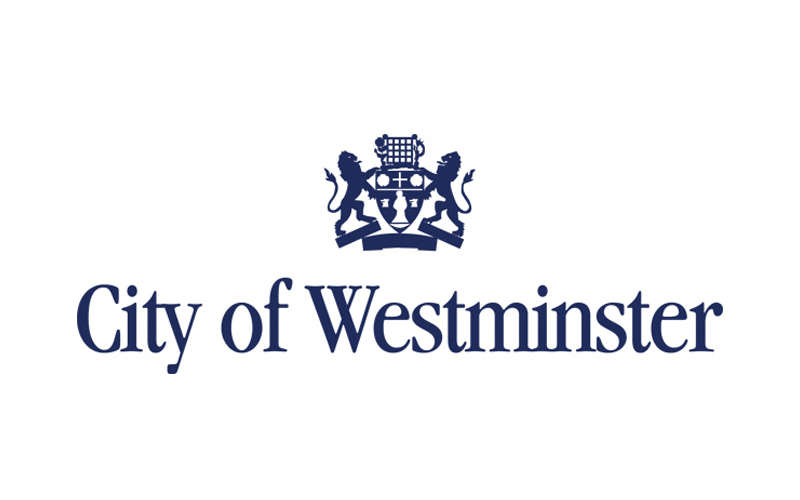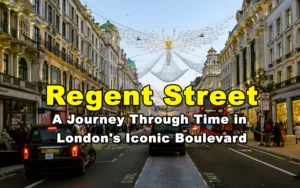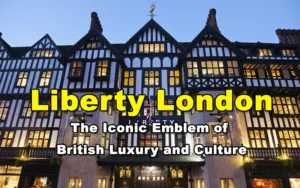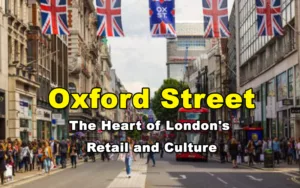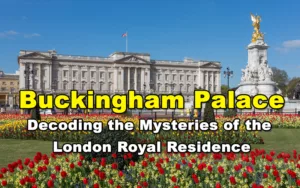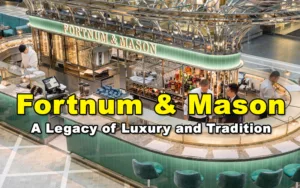Nestled in the heart of London, the City of Westminster is a remarkable place steeped in history, exuding elegance, and brimming with cultural significance at every turn. Picture a borough where centuries-old architecture seamlessly mingles with the vibrant pulse of the modern city.
It’s the kind of locale where you can stand in awe of iconic landmarks like Buckingham Palace and the Houses of Parliament, almost feeling the weight of British history that has unfolded in these very spots. Furthermore, it serves as a vibrant cultural hub, housing treasures such as Westminster Abbey and the Tate Britain, where art and heritage come together in a splendid celebration of creativity.
- A Brief Introduction to the City of Westminster
- The Houses of Parliament and Big Ben: Icons of British History and Architecture
- Westminster Abbey: A Tapestry of History, Religion, and Architecture
- Westminster Cathedral: A Gem of Byzantine Architecture in the Heart of London
- Buckingham Palace: The Resplendent Heart of British Monarchy
- Kensington Gardens: A Royal Retreat in Central London
- St. James’s Park: A Lush Oasis in the Heart of London
- Hyde Park: London’s Green Oasis
- Green Park: London’s Verdant Gem
- Regent’s Park: London’s Regal Green Escape
- Trafalgar Square: London’s Historic and Cultural Epicentre
- Whitehall: London’s Corridor of Power
- 10 Downing Street: The Heartbeat of British Political Power
- The Royal Mews and The Queen’s Gallery: A Glimpse into British Royal Splendour
- The West End: London’s Cultural and Theatrical Epicentre
- Oxford Street: London’s Iconic Shopping Destination
- Regent Street: London’s Historic Shopping Boulevard
- Bond Street: London’s Timeless Luxury Shopping Destination
- Piccadilly: London’s Pulsating Heart
- Soho: London’s Eclectic and Enduring Neighbourhood
- Cultural Significance in the City of Westminster
- The City of Westminster, A Place of Power
- Summing Up the City of Westminster
A Brief Introduction to the City of Westminster
The City of Westminster is among the 32 boroughs that make up the grand city of London. Its remarkable location, both in geographical and historical terms, bestows upon it an unparalleled importance in the city’s narrative. This borough spans the very core of Central London, including the renowned West End with its vibrant theatres and bustling streets, and stretches all the way to the serene banks of the River Thames.
The Houses of Parliament and Big Ben: Icons of British History and Architecture
The Houses of Parliament and the clock tower, commonly known as Big Ben, are iconic landmarks in London. Originally built in the 11th century as a royal residence, the current Gothic Revival design came after a fire in 1834. Interestingly, “Big Ben” refers to the bell inside the tower, not the clock or tower itself.
These structures have witnessed pivotal moments in British history and remain symbols of the UK’s democracy and architectural excellence. Standing along the River Thames, they attract numerous tourists while still serving as a vital hub for political activities and ceremonies.
Westminster Abbey: A Tapestry of History, Religion, and Architecture
Westminster Abbey, located in the heart of London, is a remarkable blend of history, religion, and architecture, playing a pivotal role in British culture for over a millennium.
Originating from the 960s and undergoing several transformations, the Abbey showcases a mix of architectural styles, from Early English Gothic to Victorian Gothic Revival, and features intricate designs and detailing. It has a deep connection with the British monarchy, serving as the coronation site for monarchs and hosting numerous royal weddings.
Additionally, the Abbey is the final resting place for around 3,300 individuals, including seventeen monarchs and many literary greats, commemorated in the famed “Poets’ Corner.” Beyond its historical and royal significance, Westminster Abbey remains an active church, engaging with contemporary issues and community outreach, continuing to link its storied past with the present.
Westminster Cathedral: A Gem of Byzantine Architecture in the Heart of London
Westminster Cathedral, different from Westminster Abbey, is the main Catholic church in England and Wales. Built in the early 20th century, its unique Byzantine design, with domes and mosaics, stands out in London. The tall bell tower offers great city views, and the inside is filled with beautiful mosaics and chapels.
As the seat of the Archbishop of Westminster, it’s a key spot for Catholic events. Plus, it has a famous choir that sings daily and hosts concerts. Overall, it’s not just a church; it’s a blend of history, art, and faith right in the heart of London.
Buckingham Palace: The Resplendent Heart of British Monarchy
Buckingham Palace in London is a big deal for the UK, representing its royal history. First built in the 1700s for the Duke of Buckingham, it later became the main home for British royals when Queen Victoria came to power in the 1800s. The Palace’s architecture showcases the work of various famed architects, and its interior includes 775 opulent rooms, notably the State Rooms used for ceremonies.
Popular attractions include the Changing of the Guard ceremony and the 42-acre garden. Additionally, the adjacent Royal Mews houses the royal carriages. Today, the Palace remains a working royal residence, hosting ceremonies and state functions, and opens its State Rooms to the public during summer, bridging its historical legacy with contemporary significance.
Kensington Gardens: A Royal Retreat in Central London
Kensington Gardens, once the grounds for Kensington Palace, is a serene 265-acre space in London. It’s packed with history, from the palace itself to Queen Victoria’s Albert Memorial. Visitors love the Peter Pan statue, recalling J.M. Barrie’s classic, and kids adore the Diana, Princess of Wales’ Memorial Playground inspired by Neverland.
The park also has the Serpentine Galleries for art lovers and the picturesque Italian Gardens. Birds flock to the Round Pond, making it a quiet spot for nature enthusiasts. Today, besides its historical features, the gardens host events and offer a green retreat for city dwellers. In short, Kensington Gardens blends London’s rich history with nature and art.
St. James’s Park: A Lush Oasis in the Heart of London
St. James’s Park, located in central London, is the city’s oldest Royal Park, originally created by King Henry VIII as a deer park in the 16th century. Over time, it’s seen various transformations and today boasts a peaceful lake with diverse birds, including its iconic pelicans.
Visitors can enjoy beautiful views from the Blue Bridge, grab a bite at the park’s café, or join guided tours to learn about its history. Conveniently situated, the park is near major landmarks like Buckingham Palace. It’s a perfect mix of nature and history, offering a green escape amid urban surroundings.
Hyde Park: London’s Green Oasis
Hyde Park is a massive green space in London, originally created by Henry VIII for hunting. Opened to the public in the 1600s, it’s now a mix of history, nature, and activity. The park features The Serpentine lake, popular for boating and swimming, and the famous Speakers’ Corner, where anyone can openly share their thoughts.
There are also memorials, like one for Princess Diana, and the park often hosts big concerts, such as The Rolling Stones. Beyond events, it’s a peaceful place with gardens, birds, and a lovely atmosphere. Simply put, Hyde Park is where London’s history, culture, and nature come together.
Green Park: London’s Verdant Gem
Green Park is a calm oasis in the heart of London, known for its vast grasslands and mature trees. Dating back to the 16th century, it was once a burial ground, hunting site, and dueling spot. Covering 40 acres, the park bursts into a sea of yellow with daffodils in spring.
While it’s minimalistic, lacking lakes or numerous statues, it houses the Canada Memorial honoring Canadian soldiers from the World Wars. The park is right next to Buckingham Palace and provides a lovely backdrop for the Changing of the Guard. Whether for events, jogging, or just relaxing, Green Park offers a peaceful break from city life.
Regent’s Park: London’s Regal Green Escape
Regent’s Park, located in central London, was designed in the 19th century by John Nash. Once a hunting ground for Henry VIII, it’s now a mix of gardens, sports areas, and attractions. Highlights include the historic London Zoo, the beautiful Queen Mary’s Gardens filled with roses, and a unique Open Air Theatre.
You can also enjoy boating, check out various sports facilities, and attend many events from concerts to festivals. Close by, the Regent’s Canal leads to Little Venice, and Primrose Hill offers great city views. In short, Regent’s Park is a blend of London’s history, nature, and vibrant cultural scene.
Trafalgar Square: London’s Historic and Cultural Epicentre
Trafalgar Square is a central spot in London that’s rich in history and culture. Named after a key naval victory in 1805, its main feature is Nelson’s Column, surrounded by four giant lions. The square boasts two impressive fountains and is home to the National Gallery, a major art museum.
Nowadays, it’s not just about history; the square hosts various events, from festivals to protests. There’s also a special spot called the Fourth Plinth, which displays changing modern art pieces. In essence, Trafalgar Square is where London’s past meets its present, making it a must-visit for both locals and tourists.
Whitehall: London’s Corridor of Power
Whitehall is a major street in Central London, known as the UK’s political hub. It got its name from the old Palace of Whitehall, where monarchs lived till 1698. Today, it’s packed with government departments, including the famous Downing Street, where the Prime Minister lives.
Key landmarks there include The Cenotaph, a war memorial; Horse Guards, known for its traditional ceremonies; and Banqueting House, the only bit left of the old palace. Besides politics, Whitehall hosts big ceremonies and has popped up in books and movies over the years. In short, it’s a mix of British history, politics, and culture.
10 Downing Street: The Heartbeat of British Political Power
10 Downing Street, often called “Number 10”, is the official home and office of the UK Prime Minister. Built in the 1680s, it became the Prime Minister’s residence in 1735 with Sir Robert Walpole. While it looks simple from the outside with its famous black door, inside it’s vast with over 100 rooms.
The building has seen major decisions, especially during the World Wars, and “Downing Street” has become shorthand for the UK government’s actions. Today, it’s not just a residence but also a modern media hub, showcasing the blend of history and current events in British politics.
The Royal Mews and The Queen’s Gallery: A Glimpse into British Royal Splendour
The Royal Mews and The Queen’s Gallery in London give visitors a special look into British royal life. The Royal Mews, originally a place for royal hawks, is now a working stable showcasing grand carriages like the Gold State Coach and horses used in official ceremonies.
Meanwhile, The Queen’s Gallery, built on a former chapel site damaged in WWII, displays rotating art exhibitions from the Royal Collection, featuring works by famous artists like da Vinci. While the Mews reveals the pageantry of royal events, the Gallery offers a visual trip through art and history, making both places must-visits for those interested in royal heritage.
The West End: London’s Cultural and Theatrical Epicentre
The West End is like London’s Broadway, right in the city’s centre. It started becoming popular in the 1800s and today, it’s home to more than 40 famous theatres. While classics like “Les Misérables” draw international audiences, the area also promotes experimental plays.
But there’s more than just theatre; the West End is packed with restaurants, shops, and historic sites, making it a hotspot for both entertainment and daily life. Its influence is global, with many shows starting there and then heading to places like Broadway. In essence, the West End captures the essence of London’s rich performing arts heritage and bustling urban life.
Oxford Street: London’s Iconic Shopping Destination
Oxford Street in London is a renowned shopping destination that blends history, fashion, and culture. Starting as a modest street in the 18th century, it evolved into a bustling shopping hub with iconic department stores like Selfridges and Debenhams.
Shoppers can explore high street brands, luxury boutiques, and designer labels. Oxford Street is also famous for its dazzling Christmas lights and lively street performers. Accessible by public transport, it’s a must-visit for those seeking the latest trends and a taste of London’s vibrant culture. Oxford Street is where shopping meets history and modernity in the heart of the city.
Regent Street: London’s Historic Shopping Boulevard
Regent Street, located in London’s West End, is a captivating shopping boulevard that effortlessly blends together shopping, culture, and stunning architecture. It was masterfully designed by the renowned architect John Nash in the 19th century and received its name in honour of King George IV. Opening its doors in 1825, the street swiftly gained fame for its luxurious atmosphere and offerings.
The street is famous for its flagship stores like Hamleys and Liberty, offering a wide range of fashion and lifestyle options. Its architectural charm is evident in the neoclassical buildings and All Souls Church. Regent Street hosts various events and is easily accessible by public transport. It’s a quintessential London experience where history and contemporary retail blend seamlessly.
Bond Street: London’s Timeless Luxury Shopping Destination
Bond Street, nestled in London’s upscale Mayfair district, is a legendary hub of luxury shopping. Steeped in history dating back to the 18th century, it exudes elegance with its Georgian and Regency architecture. This street is renowned for its designer boutiques, including Chanel and Louis Vuitton, offering exclusive collections and impeccable service.
Bond Street is also a haven for art and antiques, with prestigious galleries and auction houses like Sotheby’s. Its fine jewellery stores, such as Cartier and Graff, showcase dazzling creations. Nearby, the Royal Academy of Arts and the iconic Claridge’s Hotel add to its cultural appeal. Accessible by public transport, Bond Street is a place where luxury, craftsmanship, and culture converge, offering a timeless and enchanting experience.
Piccadilly: London’s Pulsating Heart
Piccadilly is a vibrant part of central London with a rich history. It got its name from a 17th-century tailor and has grown into a bustling area for both culture and business. You can admire its beautiful Regency-era architecture and enjoy shopping in places like the charming Piccadilly Arcade and the famous Fortnum & Mason store.
You will find the luxurious Ritz Hotel and the vibrant Piccadilly Circus close by. It’s the place to experience luxury shopping and the buzz of London.
Soho: London’s Eclectic and Enduring Neighbourhood
Soho, nestled in London’s West End, is a neighbourhood renowned for its rich history, cultural diversity, and vibrant atmosphere. It has transformed from farmland to a fashionable district and later became a creative hub for music, arts, and cinema. Soho boasts a lively nightlife, diverse culinary scene, and a thriving artistic community, with independent shops adding to its charm.
In essence, Soho is a place where tradition and modernity coexist, offering an ever-evolving cultural experience at the heart of London.
Cultural Significance in the City of Westminster
The City of Westminster isn’t just about grand buildings and open squares; it’s a melting pot of cultures, traditions, and histories. The borough hosts a myriad of festivals, parades, and events year-round, celebrating everything from national holidays to global cultures. From the grandeur of the Lord Mayor’s Show to the festive lights of Diwali, Westminster is a stage where traditions, old and new, come alive.
The City of Westminster, A Place of Power
Westminster’s importance isn’t limited to its tourist attractions. It’s the seat of power and governance in the UK. With the Houses of Parliament, the Prime Minister’s residence, and multiple embassies and high commissions, decisions made in Westminster echo not just through London or England, but often throughout the world.
Summing Up the City of Westminster
The City of Westminster shines as a true treasure in the heart of London. Its rich historical heritage, significant role in the political landscape, and abundant cultural riches make it an essential visit within the British capital. From the majestic allure of Buckingham Palace to the serene grandeur of Westminster Abbey, this borough invites you on a captivating exploration through the pages of British history.
Westminster’s significance in the political landscape, with landmarks like the iconic Houses of Parliament and the historic 10 Downing Street, adds a contemporary dimension to its timeless charm. The bustling debates and the enchanting Changing of the Guard ceremony in Parliament Square serve as vivid reminders of the democratic spirit that thrives here.
Culture enthusiasts will find themselves immersed in art at the Tate Britain and awed by the architectural grandeur of Westminster Abbey. And for those seeking culinary adventures, Westminster offers a delightful array of dining options, from traditional British cuisine to global flavours.
Whether you’re drawn by its history, politics, culture, or simply the refined ambiance of London, Westminster promises a fulfilling experience. It’s a place where the past seamlessly melds with the present, inviting all to explore its riches and embrace the essence of this extraordinary city.
“I may earn commissions as an affiliate from sponsored links within this post”


